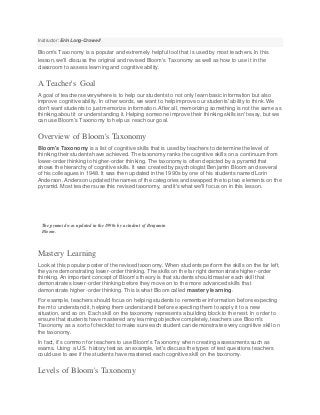
Blooms taxonomy
- 1. Instructor: Erin Long-Crowell Bloom's Taxonomy is a popular and extremely helpful tool that is used by most teachers. In this lesson, we'll discuss the original and revised Bloom's Taxonomy as well as how to use it in the classroom to assess learning and cognitive ability. A Teacher's Goal A goal of teachers everywhere is to help our students to not only learn basic information but also improve cognitive ability. In other words, we want to help improve our students' ability to think. We don't want students to just memorize information. After all, memorizing something is not the same as thinking about it or understanding it. Helping someone improve their thinking skills isn't easy, but we can use Bloom's Taxonomy to help us reach our goal. Overview of Bloom's Taxonomy Bloom's Taxonomy is a list of cognitive skills that is used by teachers to determine the level of thinking their students have achieved. The taxonomy ranks the cognitive skills on a continuum from lower-order thinking to higher-order thinking. The taxonomy is often depicted by a pyramid that shows the hierarchy of cognitive skills. It was created by psychologist Benjamin Bloom and several of his colleagues in 1948. It was then updated in the 1990s by one of his students named Lorin Anderson. Anderson updated the names of the categories and swapped the top two elements on the pyramid. Most teachers use this revised taxonomy, and it's what we'll focus on in this lesson. The pyramid was updated in the 1990s by a student of Benjamin Bloom. Mastery Learning Look at this popular poster of the revised taxonomy. When students perform the skills on the far left, they are demonstrating lower-order thinking. The skills on the far right demonstrate higher-order thinking. An important concept of Bloom's theory is that students should master each skill that demonstrates lower-order thinking before they move on to the more advanced skills that demonstrate higher-order thinking. This is what Bloom called mastery learning. For example, teachers should focus on helping students to remember information before expecting them to understand it, helping them understand it before expecting them to apply it to a new situation, and so on. Each skill on the taxonomy represents a building block to the next. In order to ensure that students have mastered any learning objective completely, teachers use Bloom's Taxonomy as a sort of checklist to make sure each student can demonstrate every cognitive skill on the taxonomy. In fact, it's common for teachers to use Bloom's Taxonomy when creating assessments such as exams. Using a U.S. history test as an example, let's discuss the types of test questions teachers could use to see if the students have mastered each cognitive skill on the taxonomy. Levels of Bloom's Taxonomy
- 2. Remembering (or knowledge) is the lowest level of the taxonomy. Just like it sounds, it simply means that the students can remember the information. They should be able to recall, define, or recite something. A teacher could assess remembering by requiring any of these skills on an exam. For example, on our U.S. history test, we could ask students 'In what year was John Quincy Adams elected as the sixth U.S. president?' If the students answer the question correctly, they have shown that they can remember the information and have mastered that level of the taxonomy. Understanding (or comprehension) is the next level of the taxonomy. To show understanding, students should be able to put the information in their own words. They should also be able to explain, translate, or summarize the information. If we were trying to assess understanding, we could include this question on our U.S. history exam: 'Explain in your own words why the colonists at Plymouth invited the Indians to the very first Thanksgiving.' A student that is able to articulate the answer well is demonstrating that not only is she able to remember the information, she also understands what it means. The next level is applying (or application). For this level, students demonstrate that they can apply the lesson to their own life or use the information in some way. They should be able to demonstrate, operate, or relate the same information in different scenarios. As we discussed before, one tenet of Bloom's Taxonomy is that each level acts as a building block to the next. Students would have to understand the information before they could apply it. An example of a test question that would assess application would be 'What questions would you ask in an interview with Abraham Lincoln?' The response to this question shows that the students can use the information about Lincoln that they remember and understand it well enough to formulate questions to ask him. To unlock this lesson you must be a Study.com Member. Create your account
